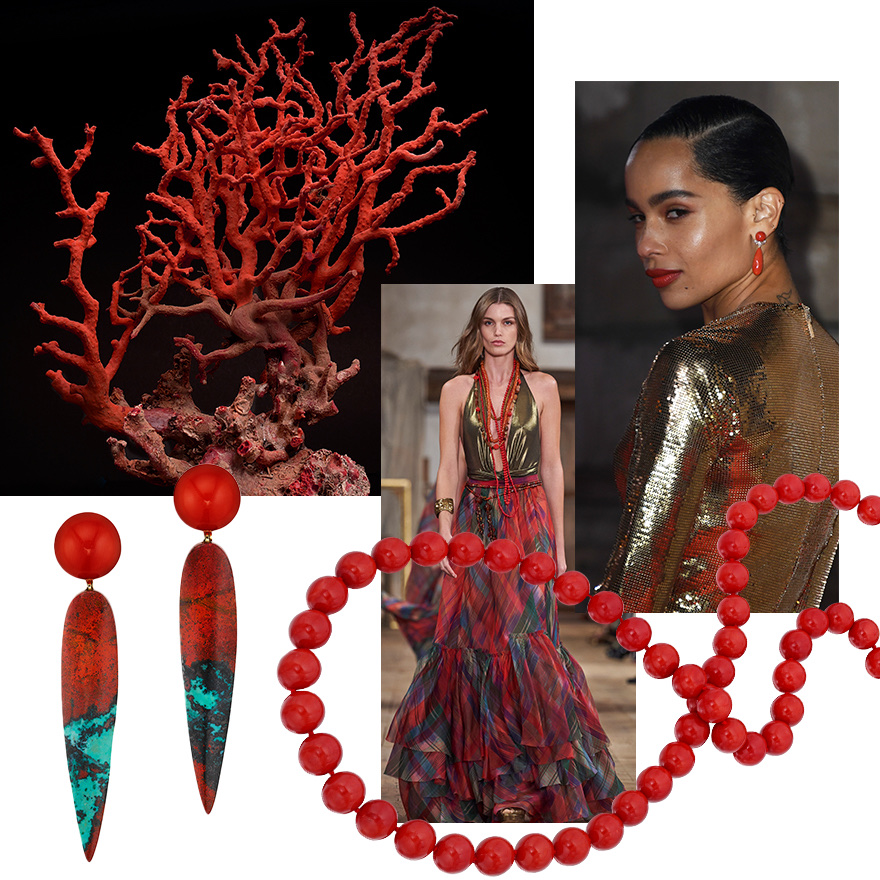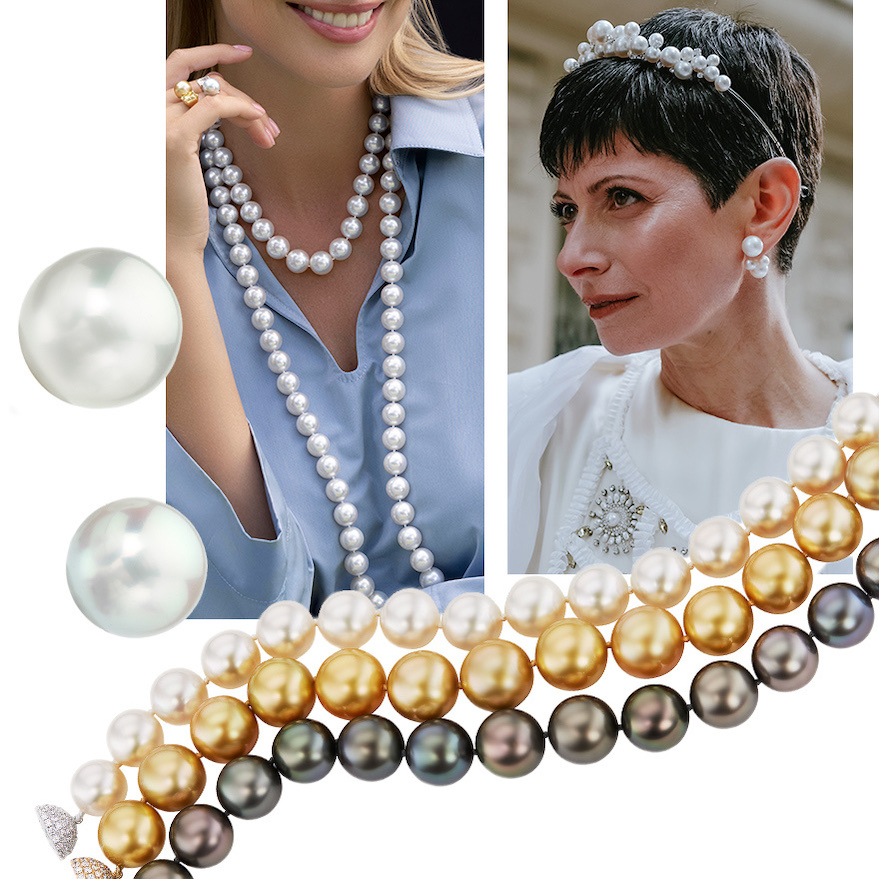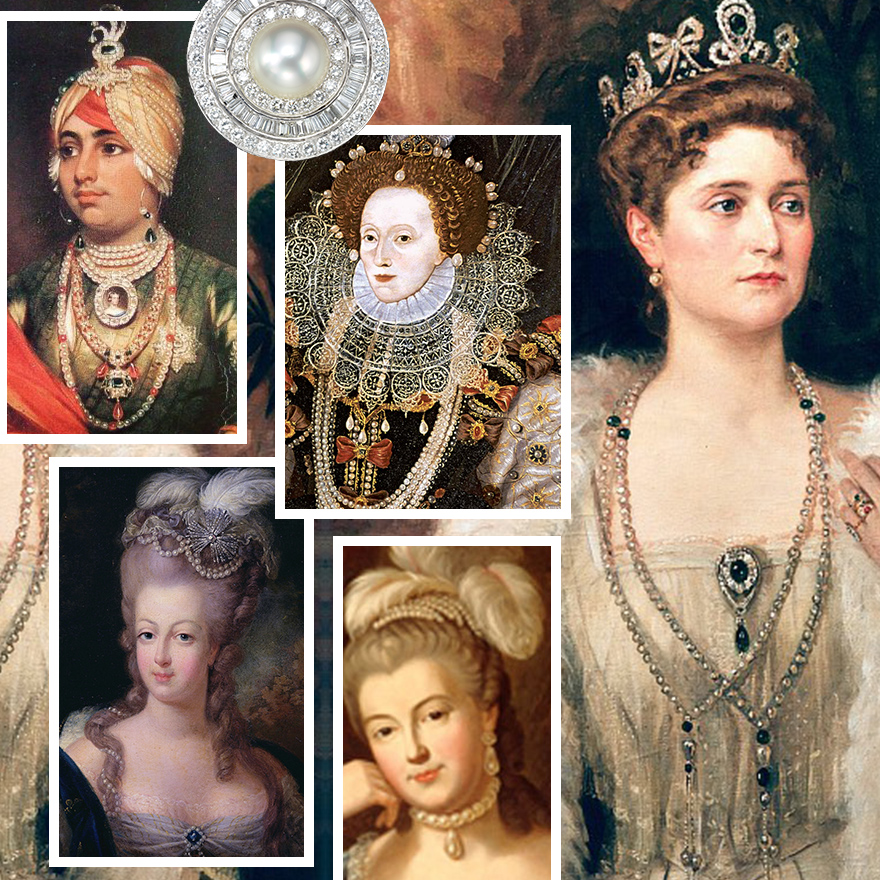
Pearls in Portraits – The Epitome of Sophistication for Thousands of Years
Since the beginning of human civilization, people of wealth and stature have had their portraits painted. Often there was strategy involved in the production of a portrait. According to the Tate Museum in London, “Before the invention of photography, a painted, sculpted, or drawn portrait was the only way to record the appearance of someone. But portraits have always been more than just a record. They have been used to show the power, importance, virtue, beauty, wealth, taste, learning or other qualities of the sitter.” No surprise, then, that pearls are prevalent in many portrayals of powerful people throughout history. Let’s take a look at how #powerpearls began and their use to convey status since the rise of Humanism in the Renaissance.
Royalty
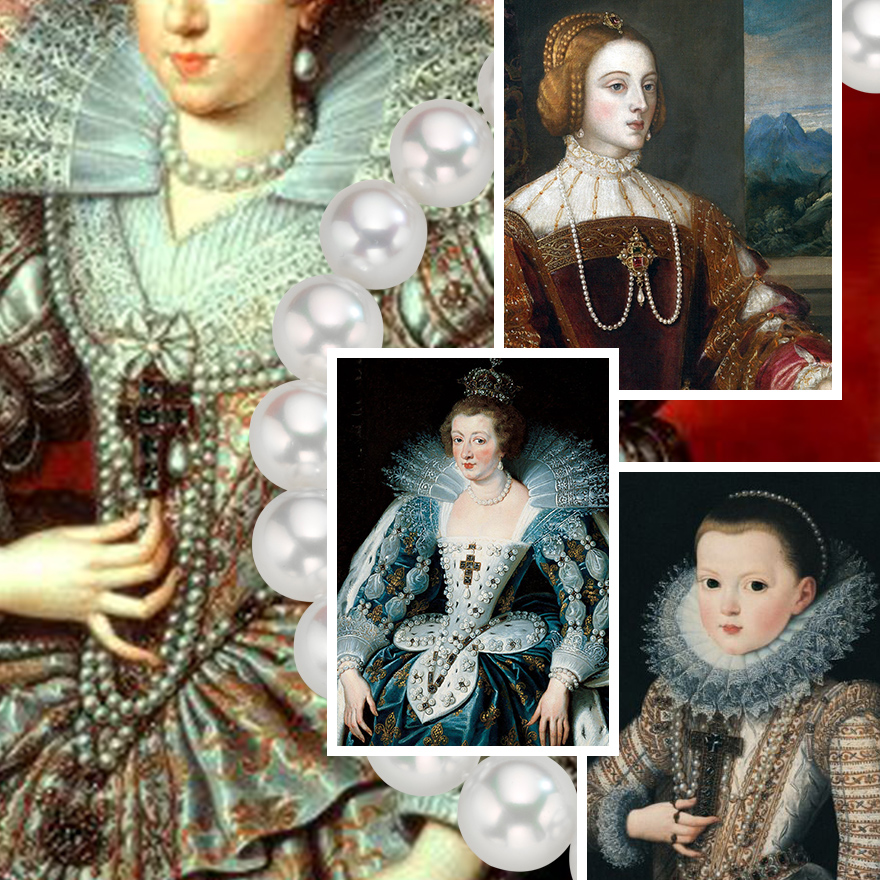
Clockwise from Upper Left – Ana of Austria by Frans the Younger 1616, The Netherlands / Isabella de Aviz, Titian 1548 Prado (Spain) / Ana Mauricia Infanta of Spain as a child (later Queen of France) 1607, Juan Pantoja de la Cruz, Spain / Ana of Austria, Peter Paul Rubens 1625, Belgium
“It should never be hard to spot the king,” the Met Museum’s Jewelry: The Body Transformed exhibition from November 2018 reminded us. This was one reason cited for the prevalence of jewelry and adornment in portraits of royalty throughout history. According to Elyse Zorn Karlin, Co-Director of the Association for the Study of Jewelry and Related Arts, “Historically, only royalty and the wealthiest people could afford to own pearls, which were all natural until the early 20th century.” The kings and queens of Europe often included pearls in their portraits to convey their privileged and elite status, as well as symbolizing the wealth and power of the nation they ruled.
“Natural pearls were rare and extremely costly because of the dangerous way in which pearls had to be found,” says Karlin. “For thousands of years, seawater pearls were brought up by divers in the Indian Ocean in areas such as the Persian Gulf. This was risky work because they had no equipment or breathing apparatus. Only a very small number of pearl divers still work today.” That limited supply and coveted mystique made pearls a continuing favorite among powerful men and women of royalty.
Isabella, Holy Roman Empress and Queen Consort of Spain was pained by the Italian Renaissance artist Titian in an extraordinary pearl necklace with a very large tear-shaped pearl hanging from a gemstone centerpiece. Some believe this pear-shaped pearl to be the famous La Peregrina which eventually became a Valentine’s gift to Elizabeth Taylor from Sir Richard Burton, but there is no conclusive evidence to prove it.
In the Northern Renaissance, Peter Paul Rubens painted Anne of Austria as Queen of France circa 1625 wearing a spectacular strand of large baroque pearls and elongated pearl drop earrings. Interestingly, she had also been painted as a maiden by Frans the Younger wearing the same choker and earrings but with additional strands of pearls looped in layers at her bodice (as shown here), potentially signifying her virginity was kept intact. It was not unusual for the younger generation of royalty to also be wearing pearls. In 1607, Juan Pantoja de la Cruz painted Infanta Ana Mauricia, the daughter of the King of Spain with lengthy pearls adorning her bodice and a lovely strand worn across her head like a headband. She later became the Queen of France when she married at 14 to Louis XIII.

Clockwise from Upper Left – Maharaja Dilip Singh of Lahore. 1852. Portrait by George Beechy, India / Assael Classic Diamond and South Sea Pearl Brooch / Queen Elizabeth I of England, Armada Portrait, 1588 / Russian Tsarina Alexandra (Romanov dynasty), 1907, Nikolai Kornilovich, Russia / Marie-Catherine Brignole-Sade 18th Century / Marie Antoinette, 1775 France
In 1588, when the English defeated the Spanish Armada, Queen Elizabeth I commissioned three “Armada Portraits.” The one shown here features tons of symbolism of English wealth and power. The queen is draped in layers of highly prized pearls, along with pearls in her hair, her ears and her clothing. She also has her hand upon the globe symbolizing the international power of the British Empire, and the background shows paintings of two different stages in the defeat of the Armada.
In the 18th century, the infamous Queen Marie Antoinette of France displayed breathtaking pearls in her hair and at her cleavage. The Princess of Monaco Marie-Catherine Brignole-Sade followed suit. She was beautifully portrayed in the same century with a large pearl choker necklace and earrings and both pearls and feathers in her hair. Interestingly, the princess also donned a multi-strand pearl bracelet on both wrists. In Russia in 1907, Romanov Tsarina Alexandra wore two lengthy ropes of pearls set with gemstones and a fur stole in her portrait.
Aristocracy & Socialites
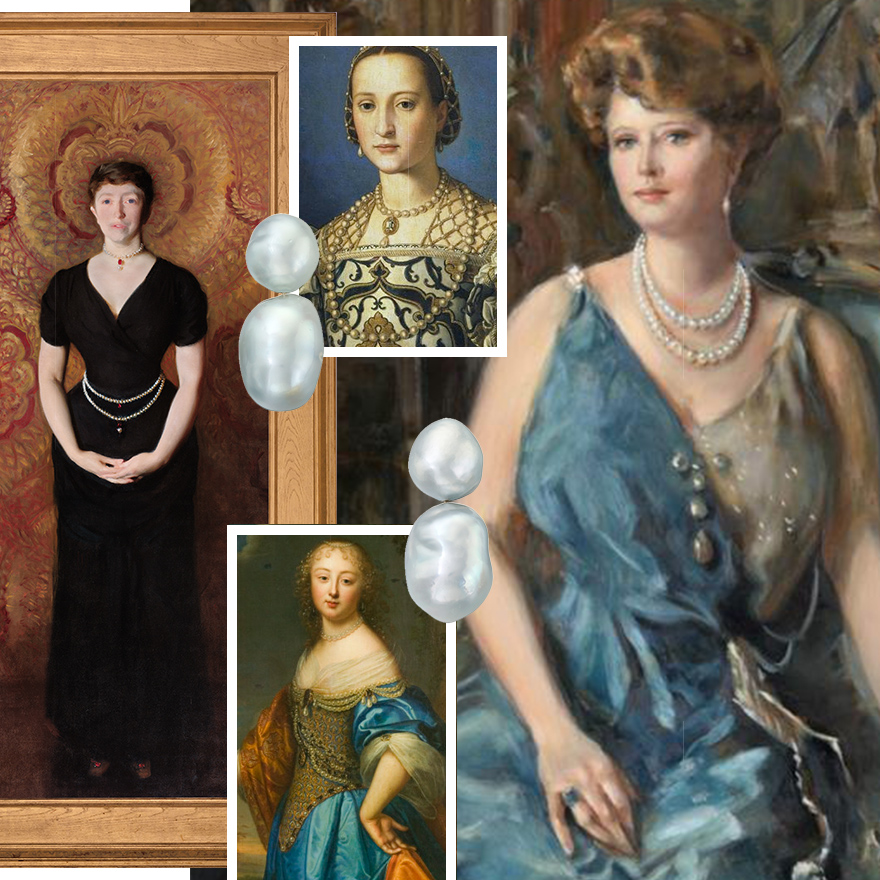
Clockwise from Upper Left – Isabella Stewart Gardner, 1881 John Singer Sargent, America / Eleanor of Toledo, 1545 Bronzino, Italian High Renaissance / Mae Cadwell Manwaring Plant, post WWI, Claudia Munro Kerr from an original by Alphonse Junger, America / Jeanne de Marigny, 1650, Charles & Henry Beaubrun Great Britain (V&A Museum) / Assael Magnificent South Sea Baroque Pearl Earrings
The privileged aristocracy sought to maintain their positions of privilege and favor, often using portraits as public and/or spiritual propaganda. Taking cues from their kings and queens, many members of the nobility also draped themselves in costly pearls. In the High Renaissance, Bronzino painted a few portraits of Eleanor of Toledo, the wife of Italian Duke Cosimo I de Medici and Duchess of Florence, featuring her in a round pearl choker necklace with a gold-set baroque pearl pendant combined with an impressive longer strand of pearls and drop-shape pearl earrings. She even has pearls sewn into the top of her dress. For those who love the city of Florence, Eleanor is the one who built the famed Boboli Gardens. Her original portrait shown above is now in the Uffizi Gallery.
In Paris, Charles Beaubrun painted a portrait of a lady/socialite named Jeanne de Marigny in 1650 which is now in the V&A Museum in London. She wears a pearl choker necklace and has pearls sewn into her fashionable attire, including multiple large pear-shaped pearls.
Across the pond, wealthy American women like Isabella Stewart Gardner and Mae Cadwell Manwaring Plant emulated European royalty with spectacular pearls in their portraits, as well. But some of the powerful socialites in both Europe and the states wore the pearls in more innovative ways. Gardner, as painted by John Singer Sargent in 1881, wears her pearls around her waist. In France, the “Princesse” de Broglie (courtesy title), wife of the French Prime Minister (click here to see portrait), wore her pearls wrapped around her wrist as a bracelet. Plant wears a more traditional double row pearl necklace with earrings, but she also has sizable pearls sewn into the gown she wears.
As the story goes, in 1917 Morton Plant’s wife Mae (Maisie) fell in love with some of legendary jeweler Pierre Cartier’s exquisite pearls. Plant had just put his New York mansion at Fifth Ave and 52nd Street on the market. Cartier notoriously suggested a swap as the pearls, similar to the Fifth Avenue address, were valued around one million dollars. History was made when the legendary barter between Cartier and Plant took place. Pearls are so powerful they can even buy Fifth Avenue real estate!
Courtesans & Celebrities
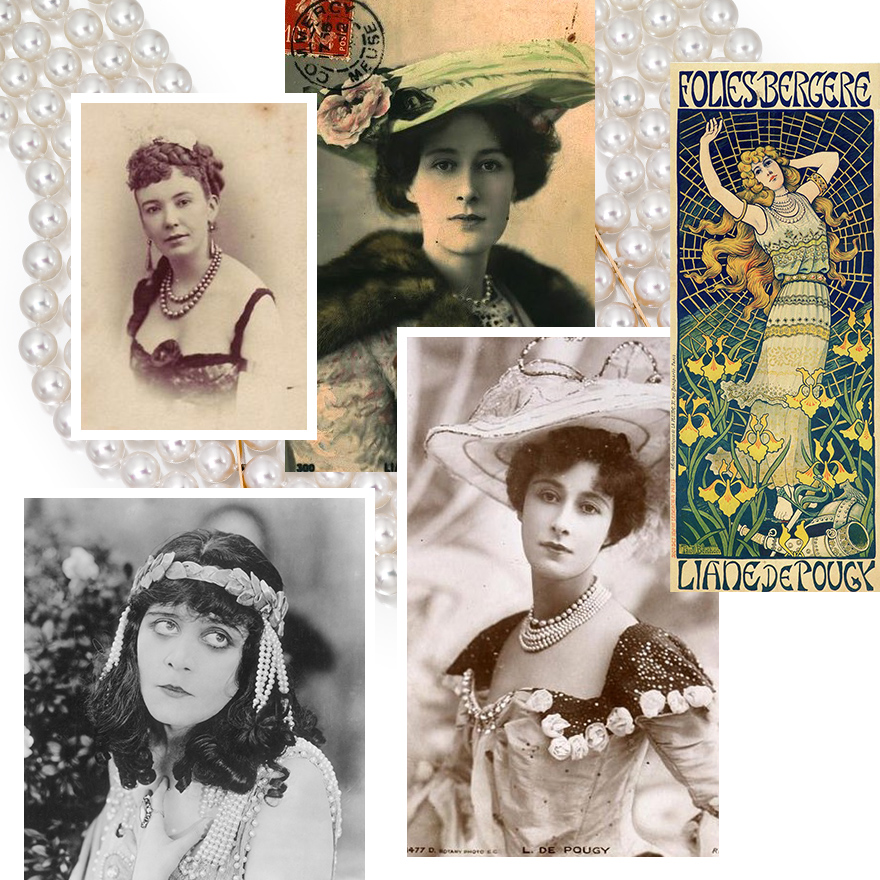
Clockwise from Upper Left – Assael Multi-strand Akoya Pearl Necklace / Coral Pearl / Liane de Pougy / Folies Bergere poster / Liane de Pougy / Theda Bara 1918
By the 20th century, portraits changed their primary medium with the invention of photography. And in terms of pearls, Koichi Mikimoto invented the process for culturing pearls, making them more available and not quite as costly. According to David Warren, Senior International Jewellery Director and Head of Jewellery Middle East for Christie’s, “The beginning of the 20th century saw a reversal of trends, as pearls (which for centuries beforehand had been the most precious gemstone known to man) began being commercially produced.”
With the rise of the famed French courtesan in the late 19th and early 20th century, women of intellect, wit and charm found a place for themselves in society entertaining wealthy and important men. Their suitors showered them with money, jewelry and servants. Many of these women were gifted pearls and wore them in polite society to prove their place. “Cora Pearl,” born Elizabeth Crouch in England, made her way to Paris, changed her name and became a sought-after courtesan. She wears a large double-row pearl necklace with elongated pearl drop earrings in her most famous photo. Liane de Pougy was a dancer from the Folies Bergere in Paris who became one of the most famous and notorious of the French courtesans. Her lesbian affair with Natalie Clifford Barney was published in her novel Idylle Sapphique published in 1901. Following her marriage, she became a philanthropist responsible for garnering funds from Coco Chanel to support an institution devoted to children with birth defects in Savoy. Liane often wore pearls along with large wide-brimmed hats.
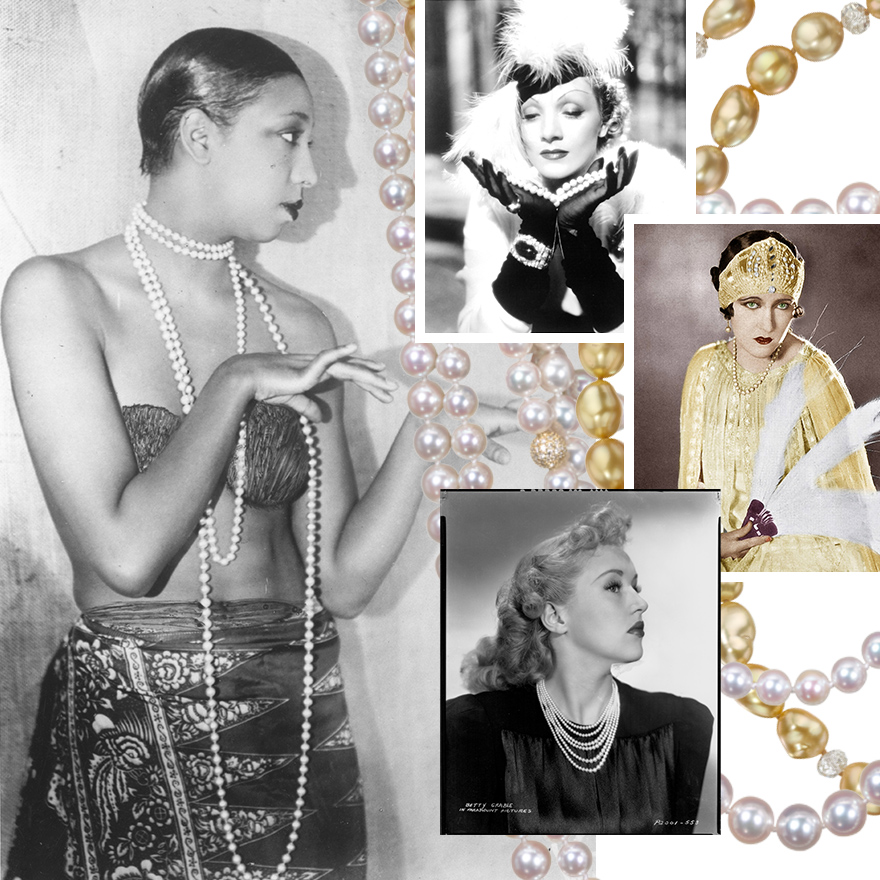
Clockwise from Left – Josephine Baker 1925 / Assael Sunset 7-Row Akoya Pearl Necklace / Marlene Dietrich 1936 / Assael Golden Keshi Pearl Necklace / Gloria Swanson / Betty Grable 1938
In the entertainment world, women were also flourishing and wearing pearls in powerful ways. Performers like Josephine Baker, Lily Marberg and Theda Bara wore their pearls with eye-catching and innovative styling. And with the invention of the talking pictures, young starlets like Mary Pickford and Gloria Swanson perfected that now famous “Old Hollywood” style with pearls in black and white portraits and publicity shots. Throughout the Great Depression, Hollywood gave downtrodden Americans much to smile about as Marlene Dietrich, Claudette Colbert and Betty Grable posed in glamorous shots with multiple ropes of pearls.
In this modern era of female empowerment, pearls are having a renaissance of their own, showing up on runways around the world in Haute Couture fashion. According to Forbes, “the pearl necklace will be one of Fall 2020’s Hottest Trends.”
Today, we are more likely to see selfies than portraits, but however you choose to strike a pose, be sure to include some #powerpearls. For some pearl inspiration, visit our Pearl Revolution board on Pinterest. Or discover your favorite types of pearls and our newest pearl jewelry designs at assael.com or by following @assaelpearls on Instagram.
If you liked this post, you might also like:
The Pearl Choker Necklace – Every Woman’s Wardrobe Essential
Posted on Jun 10, 2020 in History, Pearl Education by Duvall O'Steen
Articles you may also enjoy
Join our Mailing List
Join us for magnificent pearl trends and exclusive treasures. Discover a world that is truly ... beyond rare.

Feeling inspired?
Consider this your invitation to the House of Assael. Find your closest luxury jeweler using our map search and start your journey to timeless elegance.


